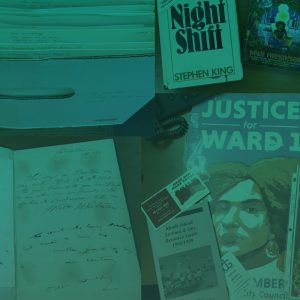E-Newsletter
Recent Posts
Latest News
-
Hay Undergraduate Fellows Showcase
|

The summer 2025 cohort of John Hay Library Undergraduate Fellows will present their projects during a showcase on Friday, October 3 at 11 a.m. in the John Hay Library Primary Source Lab (321) and on Zoom at https://brown.zoom.us/j/91641639340. Light refreshments will be served.
This year’s cohort consisted of eight incredible students who explored a wide variety of topics:
- Paulina Gąsiorowska ’27, “A Desire for the Faithful: The illuminated incunabula and medieval manuscripts of the ‘Fasciculus Temporum’”
- Coral Gimbernard ’28, “Embodying Ourselves : Exploring Feminist Responses to the Reproductive Medical Gaze in Late 20th Century Rhode Island”
- Yumna Hussen ’27, “Intellectual labour of Incarcerated Individuals, Internationalism and Black radicalism: An Analysis of Mumia Abu Jamal’s artwork”
- Lauren Levine ’27, “Southern Encounters: Imperial Networks and British Exploration of Antarctica”
- Ellanora LoGreco ’27, “The Labor of Laundry: Reconstructing Women’s Work”
- Daniella Pozo ’27, “Practical Limitations: Quilted Objects and the Women Who Make”
- Eiffel Sunga ’27, “Fight for YOUR country: A Case Study on Filipino Foreign Nationals in the U.S. Navy”
- Mahliat Tamrat ’27, “Do-It-Yourself Ethics: Grassroots Press and Black Punk Zine-Making”
Each student will present for ten minutes, covering their research and experiences at the Hay.
-
National Coming Out Day Celebration: Brown University Library x Stonewall House
|

Join the Library on the College Green for a celebration of National Coming Out Day! We’ll be partnering with Stonewall House / the LGBTQ Center to showcase LGBTQ+ and queer materials from the Rockefeller Library’s collections.
Thursday, October 9, 2025 from 11 a.m. to 2 p.m.
Score some official Coming Out Day stickers, enjoy snacks and refreshments, take a photo with the LGBTQ+ Center’s closet door, build community, and leave with a zine that shows you how to find and access queer materials at the Brown Library and beyond. Open to all!
-
Reserve Library Lockers and Carrels Online
|
Your Brown University Library now offers an online option for reserving lockers and carrels at the Rockefeller Library.
How do I reserve lockers and carrels online?

Student working at a carrel in the Rock Find all of the Rockefeller Library’s lockers and carrels in BruKnow, the online library catalog. They are organized by floor and location, making it easy to browse and find a space that works for you.
View available lockers and carrels, or search the terms “library locker” or “library carrel” in BruKnow.
Faculty, graduate students, and medical students: Select a record from the search results. Once you are in the record, click “request item” to place your request. A library staff member will then reach out via email to confirm your locker or carrel reservation.
Undergraduate thesis writers must visit the service desk at the Rock for a carrel application. The completed application must be signed by your thesis advisor and returned to the Rock service desk.
Who can reserve lockers and carrels?
Lockers: Faculty, graduate students, and medical students, and undergraduate students working on a senior thesis and may reserve lockers. You must have a carrel to reserve a locker.
Carrels: Brown graduate students and faculty members, and undergraduate students writing a senior thesis are eligible to receive a carrel.
What are library lockers and carrels?
Lockers are reservable spaces where you can securely store items that you don’t want to leave at your carrel.
Carrels are reservable study spaces that include a desk, shelving for library books, and power outlets.
Where are library lockers and carrels?
Rockefeller Library
There are lockers and carrels at the Rock.
Lockers are located on every level except for the main level. Graduate students also have access to lockers in the Wernig Graduate Student Reading Room.
Carrels are located on the perimeter of the stacks on every level except for the main level.
Orwig Music Library
Orwig Music Library also has carrels available for reservation. They are located in the Upper Reading Room and the Lower Reading Room. Orwig’s carrels can be reserved by Brown faculty members, graduate students writing a dissertation or thesis, and undergraduate students writing a thesis.
All applicants must visit the Orwig circulation desk to inquire about a carrel. Orwig’s carrels are not in BruKnow.
More Information
To learn more about library spaces and guidelines, visit Reserve Rooms, Lockers & Carrels. If you have any questions, please contact the Library at rock@brown.edu.
